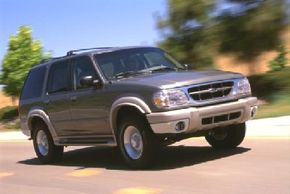1995, 1996, 1997, 1998, 1999, 2000, 2001 Ford Explorer Reliability and Safety Recalls
Here are reliability ratings and safety recall information for the 1995, 1996, 1997, 1998, 1999, 2000, and 2001 Ford Explorer:
Ford Explorer Reliability
Advertisement
Air conditioner (1995, 1996 model years): Water may drip onto the floor when the air conditioner is operated because the evaporator strip seals were not properly positioned.
Hard starting (1996): If the engine does not start, or cranks for a long time and then stalls, the idle air-control valve may be sticking.
Heater core (1995, 1996, 1997, 1998, 1999, 2000, 2001): Leaks in the heater core may be repaired by installing a restrictor in the heater inlet hose.
Keyless entry (1995, 1996, 1997): This may fail to operate due to damage from static electricity to the Remote Anti-theft Personality (RAP) module; if damage has occurred, a redundant ground must be added on the passenger seats.
Radiator (1995, 1996): The radiator may leak in cold weather because of a bad seal between the tank and core.
Suspension problems (1995, 1996, 1997, 1998, 1999, 2000, 2001): The sway bar links may bend or break because the original bushings are too rigid.
Transmission problems (1997, 1998, 1999, 2000, 2001): Transmission flare when shifting from second to third gear is due to a shift solenoid malfunction.
Vehicle noise (1995-96): A chattering noise felt coming from the rear during tight turns after highway driving may be caused by a lack of friction modifier or over-shimming of the clutch packs in the Traction-Lok limited-slip differential.
Vehicle noise (1995, 1996, 1997, 1998, 1999, 2000, 2001): Synthetic-rubber radius-arm bushings may separate internally, causing noise and degraded steering control.
Vehicle noise (1995, 1996): Loose frame rivets should be replaced with bolts (welding is not approved).
Ford Explorer Safety Recalls
1995 (two-door): Brake tubes in some models were misrouted, resulting in excessive stopping distance.
1995: Some bracket welds for the liftgate's hydraulic lift cylinder could fracture, resulting in potential for the liftgate bracket to gradually bend, allowing the ball stud to disengage.
1995: Inner tie-rod assemblies can fracture, resulting in shaking or shimmy in low-speed driving.
1995: The passenger-side airbag's inflator body may be cracked and not inflate properly; also, the igniter end cap can separate, causing hot gases to be released.
1995, 1996, 1997: The front-stabilizer-bar link stud can fracture from bending fatigue.
1996: The certification label shows incorrect rear-tire-inflation pressure.
1996: The driver's door, when closed only to secondary latched position, may not sustain the specified load.
1996: The gas-cylinder bracket may not properly support the rear liftgate.
1996, 1997 (15 northern states): The engine may not return to idle after operation at highway speeds at below 20 degrees Fahrenheit.
1997, 1998 (with 4.0-liter engine): A gap between the plate and bore of the throttle body was too narrow, causing the throttle pedal to stick.
1997, 1998 (with SOHC 4.0-liter engine): Fuel lines can be damaged and a fire could result if the vehicle is jump-started and a ground cable is attached to the fuel-line bracket near the battery.
1997, 1998: Certain off-lease vehicles, Canadian in origin but sold in the U.S., have daytime running lights that do not meet U.S. specifications.
1997, 1998, 1999: The speed-control cable on certain vehicles can interfere with the servo pulley, preventing the throttle from returning to idle when disengaging the speed control.
1998 Eddie Bauer and Limited: The key-in-ignition/door-open warning chime may not function properly.
1998, 1999: The secondary hood latch on certain vehicles may corrode and stick in open position.
1999: The right front-brake line to hydraulic control unit connection could separate, causing leakage when the brake pedal is applied.
1999, 2000 (with 3.27 or 3.55 rear axle): The powertrain-control module could allow the vehicle to exceed the design intent top speed.
1999, 2000 (with 4.0-liter engine and AWD): The generic electronic module could "lock-up," so various functions (front wipers, interior lights, 4x4 system, etc.) could not be turned on or off.
2000 (with side airbags): The side airbags could deploy if the ignition key is in the "run" position and the seatbelt webbing is extracted from locked retractor with jerking motion.
2000, 2001 (Sport and Sport Trac): The hood striker could fracture, causing the hood to fly open while the vehicle is being driven.
2001 (with high-back seats): The upper bolt on the driver's-side seat could fracture, allowing the seat to recline until it contacts an object, thus increasing the risk of a crash. Dealers would replace the driver-seat upper bolt. In addition, seats with tubular back frames would have the fully threaded lower recliner bolt replaced.
Explorer's continuing success had encouraged Ford to expand its SUV lineup, and by 2001 it could claim the industry's broadest array, from the compact Escape to the imposing Excursion. But the Explorer remained at the heart of the market, and the market was changing -- fast. Could the Explorer change with it and still be successful? You'll find the answers by going on to the next page.
For advice, reviews, photos, prices, reliability trouble spots, and even examples of used cars you're considering that are on sale in your area, check out:
- Get expert analysis of thousands of used cars over the past decade at Consumer Guide's Used Car Reviews.
- You've found the vehicle you want to buy, but only a Vehicle History Report can tell you if the odometer is accurate, if it's received any safety recall repairs, and a host of other essential information.
- The Ford Explorer has been a perennial among Consumer Guide's Best Buy and Recommended vehicles. Find out why, and learn about our other top new-car values.
